 |
 |
 |
| | Home | People behind the Scenes | Jakucho Setouchi |
| |
|
|
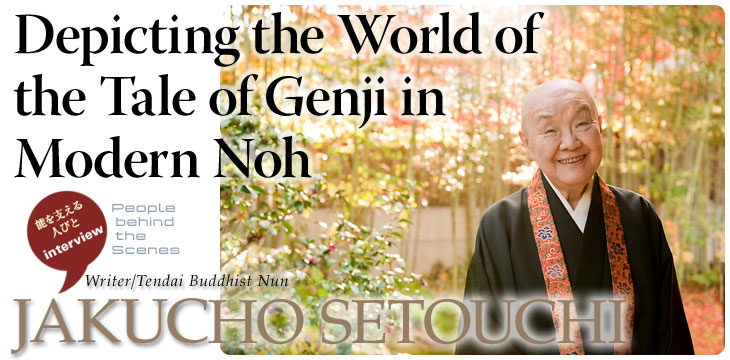 |
| Photo: Shigeyoshi Ohi |
“I wonder if today will be the last day,” she said, looking at the pile of fallen autumn leaves. She smiles and asks us almost jokingly if we would like to steam some yams. Soft beams of late-autumn sunlight shine through the clouds and into the Jakuan hermitage.
Jakucho Setouchi is also a light in the world of Noh. In 2008, the thousand-year anniversary of the Tale of Genji, I saw a performance of the popular modern Noh play she had written, Yume no Ukihashi ("The Floating Bridge of Dreams"). I felt a sense of pure enjoyment in the story depicting burning love and the sublimation of earthly desires. Then, I read her novel, Hika, which depicts the final years of Zeami. From deep down within her, many voices of that world come together and are woven into a kimono with a fabric of the deepest color. I could feel the depth and weight of that multilayered story.
I thought how wonderful it would be to meet her, a person who is the object of so much respect. This holy person accepted our small request without hesitation. We made our way to Kyoto with the sense that we were on a wonderful journey, arriving at the Jakuan of Sagano in Kyoto at the start of winter. Setouchi greeted us with her beautiful smiling face, welcomed us inside, turned quickly and skipped the long the stepping stones like a young girl.
Noh is Always Interesting
-- When did you first become involved with Noh?
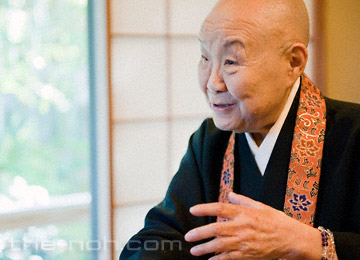 |
Photo: Shigeyoshi Ohi |
I got my first taste of Noh when I was a college student. The college I attended, Tokyo Woman's Christian University, was a school that very much liked Noh, with many Kita School teachers and students learning dance and chants. While I only sampled Noh, there were many students that danced seriously on stage. That was when I first began to like it.
Also, Noh is definitely a classical art form. The plays themselves are based on classical literature. Since I study the classics, I was naturally drawn to Noh. I later wrote modern Noh plays, and because I have an understanding of what Noh is, I now like and appreciate any Noh performance more than before. There is no particular Noh I like – I appreciate anything I watch.
The Beauty of Practice and Reticence
-- What do you find attractive about Noh?
The practice and training of Noh actors is incredible. It's just practice, practice, practice. Zeami also said that is the people who truly practice Noh that stand on stage. Even a simple extension of the hand like this is completely different with Noh actors. The extension and curving of the hand becomes a beautiful action. Just looking at it is beautiful. And the Noh costumes are so wonderful. Just looking at how they are dressed, for example and actor wearing a small mask and a karaori kimono worn in the haori style looks like a beautiful woman. Noh takes you away from the world of reality and transports your spirit to play in the dream world it depicts. That is what makes it so deeply beautiful.
Mysterious Voices
When seeing Noh for the first time, the lines and chants may be difficult to understand, but the stage is beautiful, and its simplicity is especially touching. Then, when you do understand what is being said, I think it is incredibly interesting.
What's more, the performances differ depending on the school and actors. The performance may differ even with the same actor. But no matter what the interpretation or how it is acted, there appears a complete sense of beauty. That is gradually interpreted more and more deeply, and is different every time. And with Noh, no matter who the shite is, they don't speak much. When they do speak it is only briefly. And you cannot tell whether the voice that you hear from within the mask is male or female, because the voices are so mysterious. Even in very realistic settings the ethereal appears. It is an indescribable mysteriousness that is another part of the beauty of Noh.
Writing modern Noh
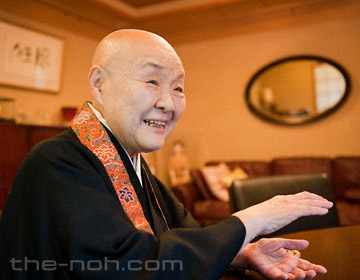 |
We held the interview in a room of the Jakuan decorated with some of Setouchi’s favorite things. Photo: Shigeyoshi Ohi |
-- We were fortunate enough to see a performance of your modern Noh work Yume no Ukihashi ("The Floating Bridge of Dreams.")
I wrote this play with quotes from Rokurô Umewaka (now Genshô Umewaka). He is a person who is interested in new things. He wanted to do something with Genji, and since I had written the Tale of Genji, he decided to base it on that. Being too stupid to be scared, I accepted his flattery and immediately began writing. In addition to Yume no Ukihashi, I also wrote modern Noh plays such as Kuchinawa based on his recommendation.
That was really fun. I knew that Noh had to be short. When Takeshi Umehara began writing kabuki, his plays were very long. He asked Ennosuke Ichikawa to help him shorten it, and a script the length of the Tokyo telephone book was shortened to around the length of the magazine (laughingly). When I heard that, knowing that Noh was shorter than kabuki because it had less dialogue, I started by writing something shorter. Rokurô offered to read it. He then asked me if he could shorten it a little. After gladly accepting, a script half the length of a magazine was reduced to the length of a postcard (laughingly). Rokurô also found this quite funny.
Tadanori Yokoo's Poster
But it is the deleted portions which really come alive on stage. What I had written was not to be explained in words but to be acted out on stage. Even short versus expand greatly when performed and the lines of the chance become even more richly wonderful with the inclusion of the hayashi. A world I couldn't have imagined appeared. I thought it was wonderful.
I called on Tadanori Yokoo to create the poster. I didn't know if such a bold poster would be appropriate for Noh, but he was quite excited to do it. Rokurô also thought the poster was wonderful when he saw it, and it was quite well received. After this Yokoo became wild about the world of Noh, and said if I was going to do Noh, he would do kyōgen, creating the set, props and costumes for kyōgen plays written by Takeshi Umehara for Shigeyama, head of the Ōkura School. These were also a great successes, and Yokoo fell even more in love with the world of Noh (laughingly).
Opera, Noh and Kabuki
-- The drafts of scripts for Noh plays have to be continually shortened – was this the same for Yume no Ukihashi?
I was asked to write the opera Ai-En. Opera is similar to Noh in that the actors sing and dance, but Noh goes through a continued process of condensation. Opera is very verbose, and the more complicated the lines and story, the more interesting. I came to understand that difference having done both. While both use singing and dancing, what is interesting is how large the difference is.
I've also written kabuki, and the lines are usually long and create the understanding of the story. But Noh is understood through not talking. That is the real difference. In kabuki, crying is depicted through actual, loud crying. While this is easy to understand, in Noh, the hand is simply placed over the face (shiori). The fact that this simple action is understood as crying is incredible.
Modern Plays and the Classics Must Match the Times
-- Yume no Ukihashi was written in response to a request by the National Noh Theatre and was first performed in 2000 (Heisei 12). We have heard that it has been performed tens of times since then. This is exceptional in that modern Noh plays are rarely re-performed.
I think it's very understandable to a modern audience. That's why I think they keep performing it. Usually with modern Noh, it will be played once and then not again for many years. Also Noh plays I have written have been performed twice yearly. I don't even know how many times Yume no Ukihashi has been performed – it's been performed in so many places.
Since Noh is a classic art form, some believe modern Noh is unnecessary. But as the times quickly change I think it's okay for new Noh to appear. I also think older Noh can be changed depending on the performance.
The Novel Hika
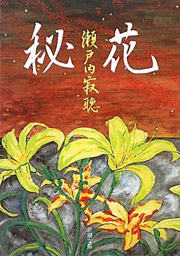 |
Hika Jakucho Setouchi, Shinchosha A popular work depicting the storied life of Zeami. |
-- You have written novel Hika, which mainly depicts the final years of Zeami. One interesting thing about this play is the multifaceted nature of the characters. How did you conceive of this play?
It was because of my involvement with Noh. I became more and more interested in Zeami the more I researched him. At 72 he was exiled to Sado, and we don't know whether he returned to Kyoto or not, although his tomb is in Kyoto. I have visited it, and it doesn't feel like his spirit rests there. It was built long after his death, and it doesn't feel like the grave of Zeami. Also there is no record in any documents of his having returned. While everyone does feel that he did return, I don't believe so. I don't feel like I would've returned if I were him.
-- There is no gravesite in Sado…
There is no grave, but Sado was where Zeami was. I have been to every other place related to him. Sado is interesting because of the different kind of people that were banished there. Sado is full of delicious things to eat – I know because I've been there, The food is truly sumptuous. It is surrounded by the ocean, and there are warm currents and cold currents. That's why there are so many different kinds of fish.
There are mountains in the middle of the island, which are also full of things to eat. There is also delicious rice, and the water is good. That also means that the sake is good. It has always been good, even now. People who live in places with delicious food are generous. They accept anyone happily. Sado is also like this. Because of how much food there is, they have rich, kind hearts. They accept anyone, even those who have been banished. That's why those banished there don't suffer. I understood this after going to Sado and becoming friends with its people.
Not Old at 85
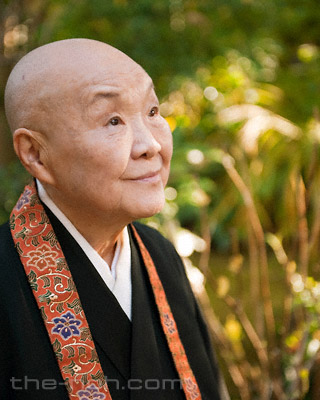 |
On the grounds of the Jakuan in autumn. Photo: Shigeyoshi Ohi |
Since Zeami was well respected, I don't think he had that much trouble. What we do know for sure from the lone remaining materials is that one of his children, Zenchiku Konparu sent him money, and that this was not a small amount of money. It was incredibly large sum. There is a letter written directly by Zeami in thanks for this. This letter states that it was thanks to this that he was able to maintain his honour. It wasn't just enough money to keep him fed. It was enough that he could maintain his honour and live a rich lifestyle.
I think that he lived there until 82. That's quite an old age, very different from 70 or 80 now. I wrote Hika when I was 84 or 85. At that time, I didn't feel old at all. 86 was tough, and I was rushed quite a bit in the 1000th anniversary of the Tale of Genji (laughingly). After having finished that and now being 87, now I feel old. Until then I was never really aware of age. But now my hearing has gotten worse and I recently had surgery for cataracts. While that is easily fixed now, it is a symbol of my age. And while I felt that this was what growing old meant, it never depressed me. I felt I could keep going and do my job even with age.
The fact that Zeami live to 82 shows how strong he was. I think that's why he kept working until the very end. I do think he would've had trouble, and there were no hearing aids at the time. Unlike myself, he was a completely musical person. That is why I think this must have been inconvenient for him.
-- One memorable part of Hika is when a warbler comes but cannot be seen and chirps but cannot quite be heard.
This is because the things that we are looking at now cannot be seen. The more this element came out, the more interesting it became.
Respecting Style and the Ethereal
Zeami made his living selling sex to the Shôguns. That is something that can't last long. And those in power were cheat. They quickly went to younger partners when they appeared. This was obviously extremely unstable. Zeami was a small man, and was probably the one to be taken care of. While I feel that he was probably a handsome young man, it was probably not the cute or pretty thank you and I imagine. I think this is father Kan’ami was probably a very good man, a very respectable man, and very reasonable.
-- A man’s man?
Kan’ami was both masculine and sexy. Kan’ami made Zeami perform and built him as an actor, although he passed away early.
-- While Kan’ami lived a happy life together with the success of his troop, Zeami probably lived a life of struggle.
But Noh has survived this long and has a theory. He must have been an incredible person.
-- In Hika, you wrote about both style and the ethereal.
I wrote the last part of the novel almost without sleep. It just came to me in a flash. In one word, Zeami's style was "sexiness." That's right isn't it? On stage, if an actor is said to have style, it means they are sexy. That’s what it is, style, sexiness. But I think people were still probably surprised.
“I think Noh will live on”
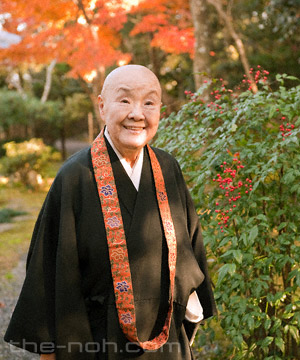 |
Photo: Shigeyoshi Ohi |
-- Listening to those involved with Noh, they are very concerned for its future. How do you feel about the future of Noh?
I think Noh will live on. Kabuki and literature have remained. I think the Japanese traditional arts such as these are strong. But I think places like Gion (Kyoto) will gradually disappear. Dances performed by individuals may also die out. But I think kabuki and Noh will live on. Also I think foreigners will enjoy them, just like we enjoy opera. I think Europeans are tired of opera (laughingly). Danjūro would be surprised if he went there.
-- There are groups of foreigners who enjoy Noh. They say that from their perspective, Noh is an amazing form of drama.
Foreigners who watch Noh and enjoy it will start to attend regularly. I think they are more impressionable than the Japanese. There is a beauty that comes from the culmination of extensive the performance, and the lines are short even when translated. Translations of long lines are boring, but Noh is more easily understood.
-- This particular person saw Hagoromo, and said that it was interesting even though they couldn't understand the lines.
Hagoromo is wonderful; it's a masterpiece. One of the great lines is, “Doubt exists with people. There is no deception in heaven.”
-- Like that line, Noh is filled with the philosophy and words of Buddhism.
Yes it is – the words of Buddhist chants and Buddhism itself. This is where the ethereal comes from – the belief that life continues. That's why it's so amazing.
I lost track of time talking with Setouchi. She was kind enough to remain with me for my entire visit, treating me to the most wonderful hospitality. Seeing how energetic she was, I had to ask her secret to health. While playing with dolls that made up a toy jazz band to the sound of music, she responded “having fun like this.” While she thought of stopping writing novels after Hika, there were many more things she wanted to write, and she has even more works ready. She is eager to write more Noh whenever there are offers. We look forward to more for work.
While speaking with Setouchi, I felt that my middle-aged mind was less open. But Setouchi seemed very flexible an lively. As Zeami explained the style that grows inside with age, Setouchi will surely bring with her flowers that bloom in any age. This can be seen in the fact that she could create a cell-phone novel like Purple, and in how many people love and depend on her. (December 2, 2009)
Profile : Jakucho Setouchi
Born in 1922 (Taishô 11) in Tokushima, Setouchi graduated from Tokyo Woman’s Christian University. In 1961, she won the Toshiko Tamura Prize for Toshiko Tamura, and in 1963 the Women’s Literature Prize for Natsu no Owari. In 1973, she joined the Chuson-ji temple in Hiraizumi, Iwate, after which she formed the Jakuan hermitage in 1974 in Sagano, Kyoto. In 1992 (Heisei 4) she won the Tanizaki Prize for Hana ni Toe, and in 1996 the Geijutsu Senshō Monbu Daijin Prize for Byakudo. In the same year, she published her ten-volume modern translation of the Tale of Genji. In 2001, she won the Noma Literary Prize for Basho. In 2006, Setouchi won Italy’s The Nonino International Prize, and in the same year Japan’s The Order of Culture. Her recent publications include Watashi no Kagerô Nikki.
| Terms of Use | Contact Us | Link to us |
Copyright©
2025
the-NOH.com All right reserved.
